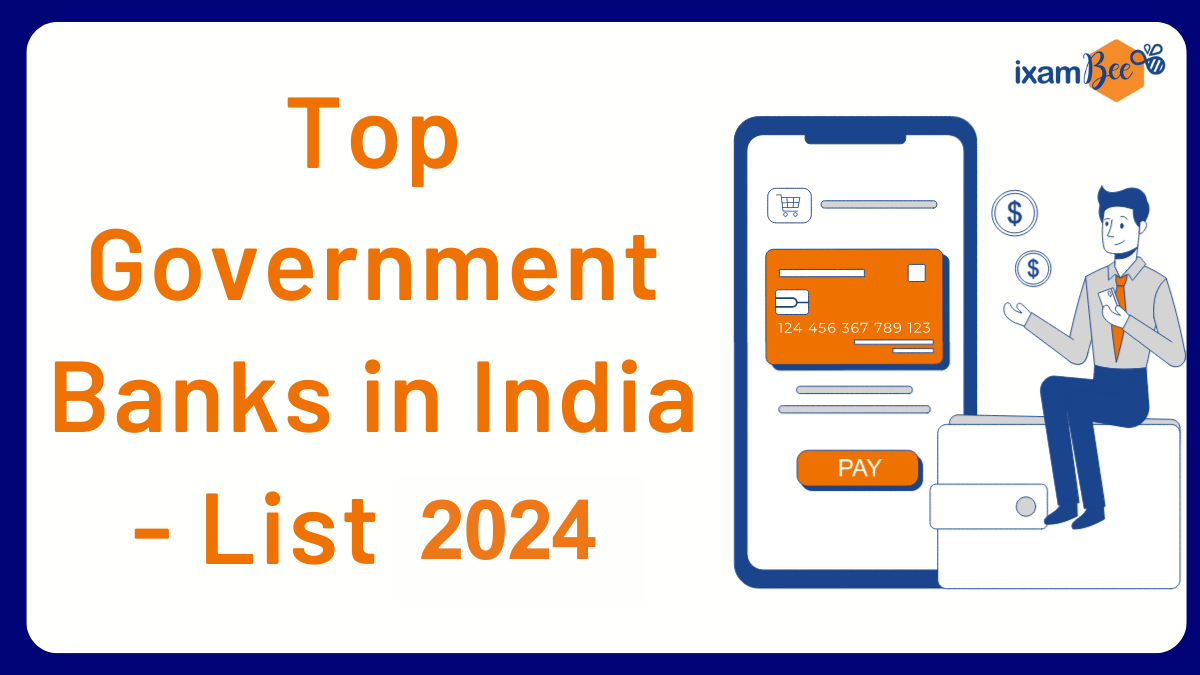The topic of government banks in India holds significant importance, particularly for aspirants preparing for competitive exams. It is a crucial component of both basic General Knowledge (GK) and current affairs, making it essential to understand public sector banks in India. A bank, fundamentally, is a financial institution authorized to accept deposits and lend money. Beyond these primary functions, banks also offer various financial services tailored to consumer needs. Among the different types of banks, public sector banks in India, also known as nationalized banks in India, play a key role in the country’s financial ecosystem.

Government banks are characterized by their ownership structure, where the majority stake—more than 51%—is held by the Government of India or the State Ministry of Finance of Indian State Governments. This ownership ensures their stability, making them vital tools for implementing financial policies, fostering economic growth, and enhancing financial inclusion. Understanding the structure and significance of the top 10 government banks in India is crucial for aspirants.
The Reserve Bank of India (RBI), as the central banking authority, regulates all banks in the country, ensuring that public sector banks in India meet the highest standards of operational integrity. Candidates must stay informed about nationalized banks in India and their post-merger status, as this information frequently appears in banking awareness sections of exams. Knowing the top 10 government banks in India and their updated profiles offers a competitive edge in both exams and interviews.
Common Questions About Government Banks in India
Aspirants often have queries about public sector banks in India, their structure, and significance. Questions like “What are nationalized banks in India?” or “How are they different from private banks?” are common in competitive exams. Understanding the list of the top 10 government banks in India and their features is essential for candidates. Queries about the role of public sector banks in India in economic growth and financial inclusion also arise frequently. Additionally, identifying the top 10 government banks in India post-merger and the evolution of nationalized banks in India is critical for thorough preparation. Aspirants preparing for Government Bank Exams in India would definitely be having some questions about them. Through this article, we hope to provide some answers to questions such as:
- What is the list of government banks in India for 2024?
- Which bank holds the top position as India’s No. 1 government bank?
- What is bank merging and its purpose?
- What are the top government banks in India for 2024?
- What is the list of government banks in India after the merger?
- What are the names of government banks in India?
- Which banks in India have been nationalized?
- Which bank was established in which year?
This comprehensive blog regarding the government banks in India aims to provide aspirants with the most relevant and up-to-date information on the subject. It is an essential resource for those preparing for bank exams and anyone interested in the banking sector in India.
What is Merging of Banks?
Bank mergers refer to the consolidation of two or more banks or financial institutions into a single entity. This process is often initiated by regulatory authorities or the banks themselves with the aim of achieving various financial, operational, and strategic advantages. The primary goal of merging banks is to create a more robust and efficient banking system that can better serve the needs of the economy and customers.
While bank mergers have been a part of India’s banking history, they have become more prominent in recent years as part of efforts to strengthen the public sector banks in India. The first major bank merger occurred in 1921, when the Bank of Bengal, Bank of Bombay, and Bank of Madras merged to form the Imperial Bank of India, which eventually evolved into the present-day State Bank of India (SBI). More recent mergers include the 2017 consolidation of SBI with its Associate Banks and Bharatiya Mahila Bank. In 2019, the merger of Bank of Baroda, Vijaya Bank, and Dena Bank took place, marking a significant shift in the landscape of Indian banking.
These recent mergers are not isolated events but part of a broader strategy to enhance the performance of nationalized banks in India, ensuring they remain competitive and better equipped to handle the financial needs of an evolving economy. Aspirants preparing for competitive exams must stay informed about these developments, especially as they impact the top 10 government banks in India.
Key Aspects of Bank Mergers and their Associated Benefits:
Bank mergers play a vital role in strengthening the financial sector by consolidating resources and improving efficiency. These mergers lead to greater financial stability, enhanced operational processes, and a broader geographical reach. By combining strengths, merged banks can offer better customer service and gain a competitive edge in the market. Here are some key aspects of Bank mergers and their associated benefits:
Enhanced Financial Stability
Bank mergers contribute to greater financial stability by consolidating resources and reducing risks. For public sector banks in India, merging creates larger institutions with better capital strength, which can withstand economic fluctuations. This stability is crucial for nationalized banks in India, enabling them to support large-scale projects and manage risks effectively. Merged banks are better equipped to handle financial crises, benefiting both the banking system and customers.
Increased Operational Efficiency
One of the key advantages of bank mergers is improved operational efficiency. By merging, public sector banks in India can eliminate redundancies and streamline processes, leading to cost savings. This efficiency boost helps nationalized banks in India deliver better services and reduce operational expenses. Merged entities can adopt new technologies more effectively, ensuring faster and more reliable banking services for customers while maximizing profits.
Wider Geographical Reach
Merging allows banks to expand their geographical presence. For example, nationalized banks in India can extend their services to new regions, enhancing customer access to banking services. Public sector banks in India, after mergers, can reach rural and underserved areas more effectively. The merged entities can leverage existing networks and infrastructure to cater to a larger customer base, thus driving financial inclusion across the country.
Improved Customer Service
Bank mergers often result in enhanced customer service by combining the best practices and resources of the merging banks. Public sector banks in India can improve their customer service infrastructure through the integration of advanced technologies and efficient systems. Nationalized banks in India can offer a wider range of products and services, ensuring better customer satisfaction. Merged banks typically provide seamless services, making banking more accessible and user-friendly.
Stronger Competitive Edge
Merging enhances a bank’s competitive position in the market. With stronger financial backing and a broader service portfolio, nationalized banks in India gain an edge over private sector competitors. Public sector banks in India that undergo mergers often experience better customer acquisition and retention rates. The resulting larger entity is more capable of competing globally, fostering growth and improving its market share while addressing the needs of the nation’s economy.
Some Major Performing Banks of India in 2024
n 2024, several banks in India have showcased exceptional performance, contributing significantly to the country’s financial landscape. Among the top 10 government banks in India, the State Bank of India (SBI) continues to lead, maintaining a dominant position with its wide reach, robust financial strength, and innovative digital services. Another standout is Bank of Baroda, which, after its merger with Vijaya Bank and Dena Bank, has emerged as one of the most formidable players in the public banking sector.
Other public sector banks in India, like Punjab National Bank (PNB) and Canara Bank, have demonstrated strong growth and resilience. These banks have consistently improved their services, adopted modern technologies, and expanded their market share. In 2024, these banks remain key contributors to India’s banking sector, enhancing financial inclusion and driving economic development. The growth of these nationalized banks in India highlights the increasing stability and competitiveness of the sector. Given below is a table that mentions some of the major performing banks in recent times.
| Name of the Bank | Features |
| State Bank of India (SBI) | State Bank of India is the largest and one of the oldest public sector banks in India, established in the year 1955. The merger has led to the State Bank of India joining the ranks of the world’s top 50 banks. It has a vast network of branches and ATMs across the country and a significant presence worldwide.SBI offers a wide range of banking and financial services to individuals, businesses, and institutions. |
| Punjab National Bank (PNB) | Punjab National Bank, established in 1894, is one of the leading public sector banks in India. It offers various banking and financial products and services, including retail banking, corporate banking, and international banking. |
| Bank of Baroda (BOB) | Bank of Baroda is another major public sector bank in India with a substantial presence both domestically and internationally. It was established in 1908. It provides a comprehensive range of banking services, including retail, corporate, and investment banking. |
| Canara Bank | Canara Bank, established in the year 1906, is known for its wide-ranging banking solutions, including retail, corporate, and international banking services. It has a significant branch network across India and serves a diverse customer base. |
| Union Bank of India | Union Bank of India is a prominent public sector bank with a strong focus on retail and corporate banking. It was established in the year 1919. It offers a variety of financial products and services to meet the needs of its customers. |
| Bank of India (BOI) | Bank of India, established in the year 1906, is one of the oldest public sector banks in India. It provides banking services such as loans, deposits, and investments to individuals and businesses. |
| Indian Bank | Indian Bank is known for its customer-centric approach and offers a wide array of financial services, including retail and corporate banking. Established in the year 1907 as part of the Swadeshi movement. |
| Central Bank of India | Central Bank of India, established in the year 1911, is one of the oldest public sector banks in India and has a significant presence in the country. It was the first Indian commercial bank which was wholly owned and managed by Indians. It provides various banking and financial services to its customers. |
| UCO Bank | Established in 1943, UCO Bank is a Kolkata-based public sector bank with a strong presence in Eastern India.It offers important banking services to a diverse customer base. |
| IDBI Bank | Established as Development Financial Institution (DFI) in the year 1964, the primary role of IDBI (Industrial Development Bank of India) is to provide financial support and assistance for the growth and development of various industries in India. While IDBI Bank was a public sector bank, it has undergone changes in its ownership and may not be entirely government-owned as of last update. It is to operate as an “Indian Private-sector bank” with 15% public-shareholding, and offers a range of financial services, including loans, investments, and project financing, to promote industrialization and economic progress in the country. |
| NABARD | NABARD (National Bank for Agriculture and Rural Development) is a DFI entrusted with the responsibility of extending and overseeing credit and related services to foster the advancement of agriculture, small-scale industries, cottage and village enterprises, handcrafts, and other rural occupations, thereby stimulating economic activities in rural regions and promoting economic growth. It was established in the year 1982. |
| Reserve Bank of India (RBI) | RBI, short for the Reserve Bank of India, commenced in 1935, as the nodal agency to operate the credit and currency system of the country to its advantage. It serves as India’s central bank and the governing authority overseeing the Indian banking sector. Operating under the purview of the Ministry of Finance, Government of India, RBI plays a pivotal role in managing the issuance, stability, and supply of the Indian rupee. Additionally, it takes charge of crucial payment systems and actively fosters the nation’s economic growth. |
Conclusion
The majority of India’s commercial banks originally operated as private entities but underwent nationalization in 1969. This strategic move by the government aimed to foster economic growth by transforming these banks into public institutions, thereby enabling them to better cater to the country’s economic requirements and facilitate business development.
It’s important to recognize that the Indian banking sector has been experiencing continuous reforms and transformations, including mergers and acquisitions, for quite some time. You can stay informed about these developments by regularly reading newspapers and economic magazines/journals.
BeePedia for General Awareness/Current Affairs
ixamBee offers a valuable resource in the form of “Beepedia” that provides a continuous stream of updated content in the fields of Current Affairs and General Awareness. This resource is exceptionally beneficial for individuals preparing for various competitive examinations, ensuring they stay well-informed about the latest events, trends, and developments across the world. By regularly updating these topics, ixamBee empowers learners to stay ahead in their exam preparation and enhance their knowledge base, thereby increasing their chances of success in competitive exams. Wishing you Good Luck!
ixamBee specializes in providing expert guidance and resources for banking exams 2024, ensuring that you are well-prepared for the Upcoming Bank Exams like RBI Grade B, NABARD Grade B, IBPS SO, and more. Our courses align with the bank exam calendar 2024, covering all the essential topics. With a focus on the upcoming bank jobs, our Previous Year Papers, BeePedia, SSC CGL, SSC CHSL, SSC MTS and other Mock Tests are designed to help you excel in upcoming banking exams.
Also Read
How to Start Preparing for the SIDBI Grade A Exam
RBI Grade B 2024 Interview Guidance
3 Mistakes to avoid in RBI Grade B Interview Preparation















